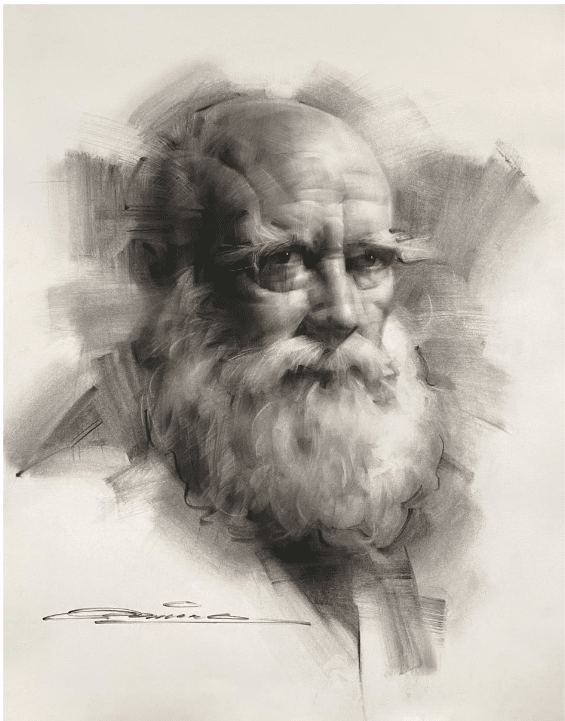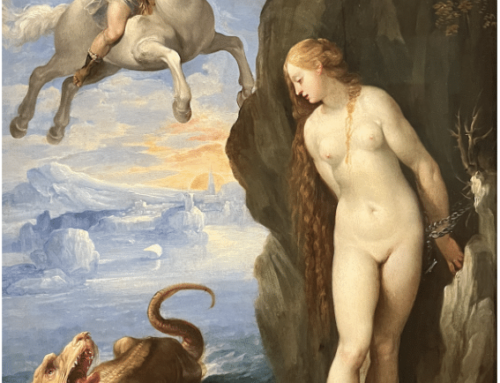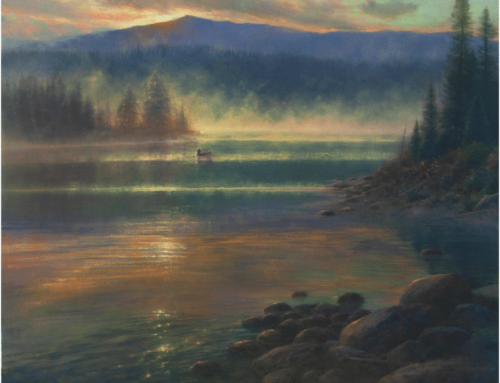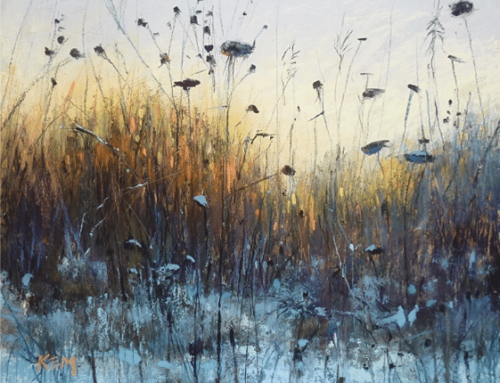Lots of people who wish they could paint say things like, “I can’t even draw a straight line.” The irony is, in painting you don’t even have to – you just have to be willing to keep adjusting and correcting until it “straightens itself out.”
For that matter, plenty of folks who become artists later in life would have started a lot sooner if they’d not been under the misguided impression that they “couldn’t draw.” There’s just this pervasive, mistaken idea that drawing is a “you-either-have-it-or-you-don’t affair.” This is simply untrue.
Anyone can learn to draw at any age. It takes time, practice and patience. That kid in your class who could draw better than everyone else? (Maybe that was you?) Likely they’d figured out how to cross-measure proportions to get a more accurate drawing. It’s a skill that all draftsmen use, and it can be taught.
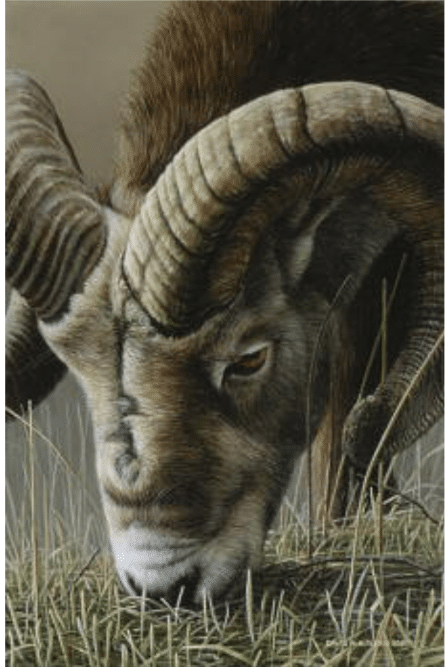
David N. Kitler, Rocky Mountain Eye
Drawing is about comparing one thing with another and making small adjustments as you go. It’s not a mysterious gift bestowed by Fate upon a select few. It turns out the basic principles are easily understood:
- Draw what you see and not what you know.
- Draw shapes and proportions before you add detail.
- Constantly make judgments and be ready with adjustments; i.e., it’s a process of always comparing your shapes, sizes, and angles with each other and your model. Adjustments will be necessary.
- Draw shapes within shapes.
- Distill the elements of draftsmanship (such as scale, proportion, rhythm, mass, shape, space, balance, volume, and perspective) into simple observations:
- How long is it?
- How high is it?
- How wide is it?
- What are the shapes, the angles, the edges, the values, and the proportions doing?
Ideally, the artist aims to balance the technical ability to draw well with a creative sense of what the drawing will represent – that is, an interesting way to depict the thing, combined with how you feel when looking at it.
Everyone has different sensibilities and interests; a style evolves from personality and preference combined with which parts of the process you give most of your attention. A person whose strengths lie in one area may want to play that up. On the other hand, they might want to concentrate on strengthening their skills in an area they’re weaker in. There are definitely rules and techniques for accurate and realistic draftsmanship, but for drawing there’s ultimately no one size fits all.
Take Advantage of What’s Available
It’s true that we learn things faster when our brains and bodies are young. But we all have different aptitudes and speeds of learning, and with the Internet chock full of tutorial videos and online classes and art events, the learning curve has flattened incredibly. In ages past, you had to apprentice to a master as a child or spend years in an academic art school to learn what you can in a matter of months online. As artists and learners, we’ve honestly never had it so good.
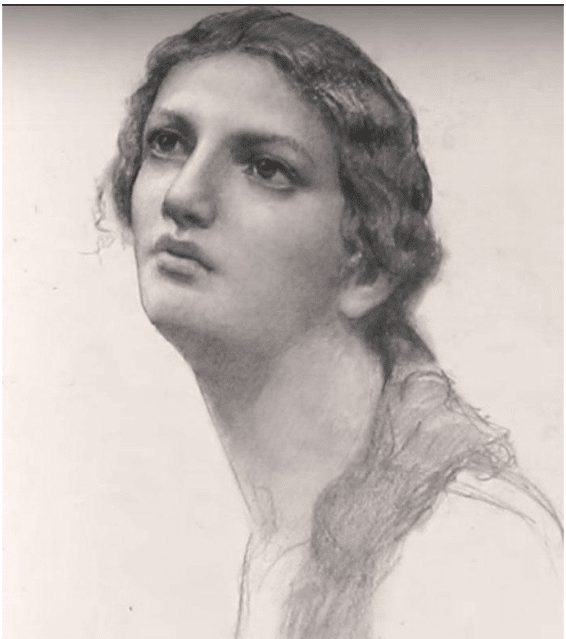
Cesar Santos, sketchbook drawing in pencil
Of course, there may be physical limitations to consider – shaking hands, failing eyesight, for example, not to mention the pressures and demands of daily life. We all face disadvantages of one kind or another. Aside from all that though, it comes down to the level of commitment and focus you can muster.
Gridding out photos and working square by square saves time but doesn’t teach you as much as working from life. However, there’s another fast way to pick up essential drawing skills, and that’s copying drawings by eye. Every beginning artist in the past was expected to make copies of the masters, and it’s still an excellent way to practice.
If you copy the drawings of any great artist, one of the things you’ll immediately sense is the quality of line – the character of an artist’s line is a very personal thing. The feel of an artist’s line might be just a function of personality, but there are things to consider even here: how heavy or light the pressure you use, how confidently or haltingly you move your hand, where you thicken or thin which areas of a contour, how rapidly or methodically you move, even the kind of writing tool you settle on using – these and more all contribute to line quality. But don’t think of it as complicated – think of it as part of the fun of learning to draw like you.
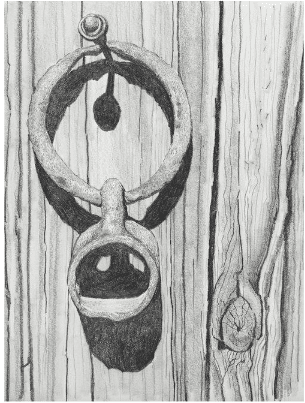
Drawing by Claudia Nice, who teaches texture drawing basics in one of her most popular videos.
No, it’s not too late and YES, you can.
There are SO MANY serious, high-quality videos for artists by all of the artists in this article and more any of which will teach you and improve your ability to draw.
We Say Goodbye to Joe Anna Arnett
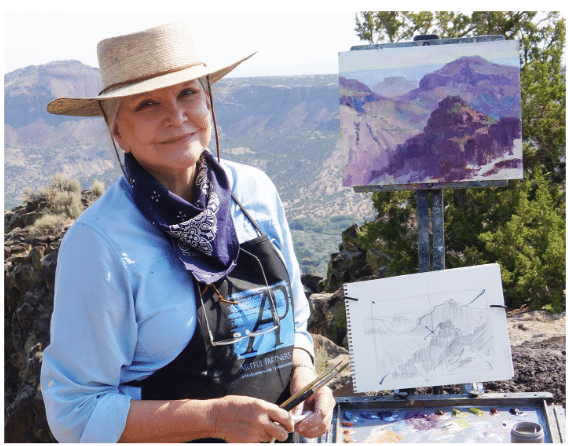
“We just have to be ready to make the jump, accept the challenge, and enjoy the journey.” ~Joe Anna Arnett
Joe Anna Arnett, distinguished artist, died the on evening of February 3, 2024, at her home in Santa Fe, New Mexico, after a long battle with cancer. She was preceded in death by her beloved husband of 33 years, James Asher. Together, they traveled the world, capturing their favorite scenes in paint. From India to Europe to South America and locations all around the United States, they shared adventures that inspired their art and enriched the lives of others.
Some of her career highlights included participating in the prestigious Artists of America show in Denver for 11 years, the Prix de West at the National Cowboy Hall of Fame for 14 years, and being represented by the prestigious Zaplin Lampert Gallery in Santa Fe for over three decades. Joe Anna is now represented at McLarry Fine Art where there is currently a special exhibit of her masterpieces.
In 1997, she became a Master Artist of the Artists in America Show at the Denver Historical Society Museum. She also exhibited at museums around the country and in 2006 was honored by the Gilcrease Museum in Tulsa, Oklahoma as one of their featured artists in the Rendezvous exhibition. Joe Anna was a Signature Member of Oil Painters of America, Signature member of Laguna Plein Air Painters and Master Signature member of Plein Air Artists Colorado, a master signature member of Plein Air Painters of New Mexico and an elected member of The Salmagundi Club. Joe Anna participated in Plein Air Maui, Plein Air Southwest, En Plein Air Texas, Paint Grand Traverse, and En Plein Air Masters in France.
“Jo Anna was a trailblazer by making the world aware of plein air painting, and she achieved a level of excellence in her paintings few ever accomplish,” said Eric Rhoads. “But it was her heart, her love of people, and her efforts to help others, which made her a spectacular human being.”
Read a longer article and additional tributes from friends and fellow artists here.

